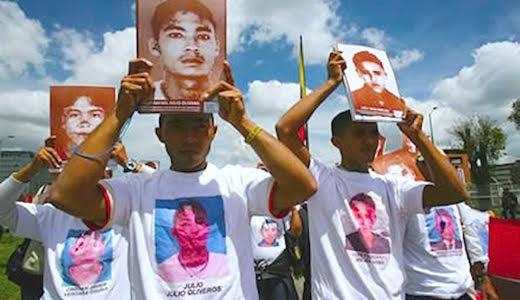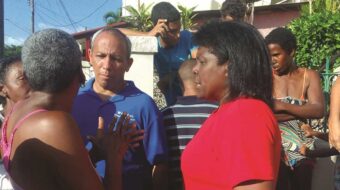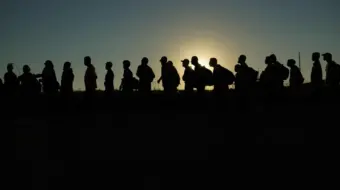
The U.S-backed Colombian government has presided over what now appears to be one of the worst cases ever of mass atrocities perpetrated against innocent civilian populations. According to new reports as many as 6,000 civilians may have been killed under the orders of generals and colonels seeking to boost their reputations as rebel-killers.
Human Rights Watch (HRW) just issued a report citing “extensive previously unpublished evidence [which] implicates many Colombian army generals and colonels in widespread and systematic extrajudicial killings of civilians between 2002 and 2008 . . . .”
HRW notes that Colombian “prosecutors are investigating at least 3,000 of these cases, in which army troops, under pressure to boost body counts in their war against armed guerrilla groups, killed civilians, and reported them as combat fatalities.” There are reports by other groups, such as the Fellowship of Reconciliation (FOR), which put the number of victims of this slaughter at closer to 6,000.
Jose Miguel Vivanco, executive Americas director of HRW, described these killings, known as the “false positive” killings, as “one of the worst episodes of mass atrocity in the Western Hemisphere in recent years.”
There is mounting evidence that many senior army officers bear responsibility. Yet the army officials in charge at the time of the killings have escaped justice and even ascended to the top of the military command, including the current heads of the army and armed forces, according to Vivanco.
While HRW rightly calls upon the U.S. to suspend military aid to the Colombian military in light of these crimes and the impunity for them, what HRW fails to mention is how the U.S. has had a direct hand in the commission of these crimes.
Thus, a damning report released by FOR demonstrates how there is a direct correlation between U.S. military funding and training, particularly at the School of the Americas (aka WHINSEC), and the incidence of human rights abuses, including “false positive” killings.
To wit, the report concluded that “of the 25 Colombian WHINSEC instructors and graduates for which any subsequent information was available, 12 of them – 48 percent – had either been charged with a serious crime or commanded units whose members had reportedly committed multiple extrajudicial killings.”
Moreover, FOR reports that “some of the officers with the largest number of civilian killings committed under their command (Generals Lasprilla Villamizar, Rodriguez Clavijo, and Montoya, and Colonel Mejia) received significantly more U.S. training, on average, than other officers” during the high water mark of the “false positive” scandal.
For its part, HRW notes that at least 44 alleged extrajudicial killings were carried out by the Fourth Brigade under the leadership of General Montoya (who then later became the army’s top commander), while at least 48 alleged false positive killings were carried out by the Ninth Brigade under the leadership of General Lasprilla Villamizar.
However, the most salient aspect of the “false positive” scandal for Americans – and the one which HRW as well as the press ignore – is that the Colombian military has been encouraging the high body count, and therefore murdering civilians to acquire it, in order to justify continued military aid from the United States which, since 2000, has given that military over $9 billion and counting to wage its counter-insurgency war.
In other words, it is the United States which is truly behind the “body count syndrome” at the heart of the “false positive scandal.” And, it cannot be said that the U.S. has somehow been encouraging body counts unwittingly, for it has been very aware of this phenomenon for many years.
As an illuminating account by Michael Evans at the National Security Archive explains, recently de-classified U.S. documents show that “the CIA and senior U.S. diplomats were aware as early as 1994 that U.S.-backed Colombian security forces engaged in ‘death squad tactics,’ cooperated with drug-running paramilitary groups, and encouraged a ‘body count syndrome…'”
Yet, despite long-standing knowledge of such crimes, the U.S. not only continued, but indeed massively increased its military aid to Colombia under the 2000 program known as Plan Colombia – the Colombians refer to that program as “Plan Washington,” for it was in the U.S. government where it truly originated.
As Michael Evans explains, the U.S. has been quite aware of Colombia’s policy of creating “false positives” for decades:
“The earliest record in the Archive’s collection referring specifically to the phenomenon dates back to 1990. That document, a cable approved by U.S. Ambassador Thomas McNamara, reported a disturbing increase in abuses attributed to the Colombian Army. In one case, McNamara disputed the military’s claim that it had killed nine guerrillas in El Ramal, Santander, on June 7 of that year.
“The investigation by Instruccion Criminal and the Procuraduria strongly suggests … that the nine were executed by the Army and then dressed in military fatigues. A military judge who arrived on the scene apparently realized that there were no bullet holes in the military uniforms to match the wounds in the victims’ bodies…”
“Similar tendencies were highlighted four years later in a cable cleared by U.S. Ambassador Myles Frechette. He found that “body count mentalities” persisted among Colombian Army officers seeking promotions. The Embassy’s Defense Attaché Office (DAO) had reported that, “Field officers who cannot show track records of aggressive anti-guerrilla activity (wherein the majority of the military’s human rights abuses occur) disadvantage themselves at promotion time.” . . .
“A CIA intelligence report, also from 1994, went even further, finding that the Colombian security forces continued to “employ death squad tactics in their counterinsurgency campaign.” . . .
“Just over ten years ago, another U.S. intelligence report, previously published by the National Security Archive, and based on a conversation with a Colombian Army colonel, suggested that the steep rise in paramilitarism during that era was related to a “body count syndrome” in the Colombian Army.
“This mindset tends to fuel human rights abuses by well-meaning soldiers trying to get their quota to impress superiors. It could also lead to a cavalier, or at least passive, approach when it comes to allowing the paramilitaries to serve as proxies for the COLAR [Colombian Army] in contributing to the guerrilla body count. The 4th Brigade, a traditional launching point for officers seeking to move up the military chain-of-command, has long been accused of collusion with local paramilitary groups. The Los Angeles Times reported in 2007 on a classified CIA report linking Gen. Montoya to joint military-paramilitary operations in Medellín while he served as brigade commander in 2002.
“In no case were the 4th Brigade’s paramilitary ties more evident than in a February 2000 false positives operation in which both the ACCU paramilitaries and the Colombian Army almost simultaneously claimed credit for having killed two long-demobilized guerrillas near Medellín. A declassified U.S. Embassy cable on the matter, signed by Ambassador Curtis Kamman, reported the case with shocked disbelief.
“The ACCU (which witnesses say kidnapped the two) claims its forces executed them, while the Army’s Fourth Brigade (which released the bodies the next day) presented the dead as ELN guerrillas killed in combat with the Army. After these competing claims sparked localized fear and confusion, armed men stole the cadavers from the morgue…
“Kamman called the killings “a clear case of Army-paramilitary complicity” that would “further increase the already high-level of international NGO interest in the issue of 4th Brigade ties to paramilitaries.”
Of course, the “false positive” scandal is but the tip of the iceberg of Colombia’s human rights nightmare. Thus, as a result of the Colombian military-paramilitary assault on the population, Colombia now has around six million internally displaced peoples, and has suffered well over 50,000 (and quite possibly 250,000) forced disappearances.
Indeed, the situation confronting Colombia can only be described as catastrophic, and this catastrophe would have been impossible without the massive military funding of the U.S. which continues to this day.
As HRW correctly concludes, this military funding must cease.
Dan Kovalik is an internationally-known labor and human rights lawyer.
Photo: From the Fellowship of Reconciliation report: The Rise and Fall of ‘False Positive’ Killings in Colombia: The Role of U.S. Military Assistance, 2000-2010. | Colombians march holding photos of the dead.












Comments